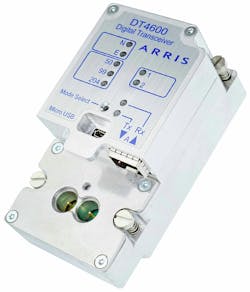CommScope today introduced what the company contends is the industry’s first 204MHz digital return platform, enabling operators to deploy a high split in their upstream band and deliver new gigabit speeds.
The new digital return solution is comprised of the CommScope DT4600N node transmitter and DR3600N headend receiver. Together, these units establish a robust optical link that delivers consistent performance across all link distances between CommScope’s widely deployed NC4000, NC2000 and OM41x0 node platforms and its popular CH3000 headend optics platform.
CommScope says its high-split (204MHz) digital return enables operators to evolve their networks, building on an installed base of optical nodes to fully capture the benefits of DOCSIS 3.1 technology. By implementing a high split with digital return, operators will be able to consistently deliver higher upstream bandwith and faster upload speeds, irrespective of link distance.
Of the new technology's benefits, the company notes:
Digital return is the only practical way to achieve the high link performance required for a fully loaded 5-204MHz upstream utilizing 1024-QAM or even higher - independent of distance, up to and even beyond 100km. The digital link enables multi-wavelength solutions with up to 80 returns (40 wavelengths) combined onto a single fiber without compromise. Activation is simple - “set-it-and-forget-it” installation - and “no-cost” remote node monitoring makes management easier than ever.
The CommScope 204MHz digital return technology extends the company's unique “multiple-mode“ philosophy, providing operators with a seamless upgrade path from mid-split (85MHz) to high-split mode and either a single- (“1-fer”) or dual-return (“2-fer”) operation on a single wavelength; a single model supports multiple bandwidths and single/two-return operation with a simple “push-button” to switch between modes, facilitating a smooth network evolution.
“Our new 204MHz digital return is the first of its kind, and one of the most highly anticipated solutions to support upstream bandwidth expansion,” comments Guy Sucharczuk, senior vice president, Access Technologies, Broadband Networks, CommScope. “With a high-split network, operators can address the tremendous bandwidth demands and the need for 1 Gbps upstream speed to meet the new global environment head-on. The new DT4600N and DR3600N build on CommScope’s proven digital return platform, offering operators a simple path to additional capacity and their network of the future.”
The CommScope 204MHz digital return platform is in trials with a number of operators, and is broadly available now.
